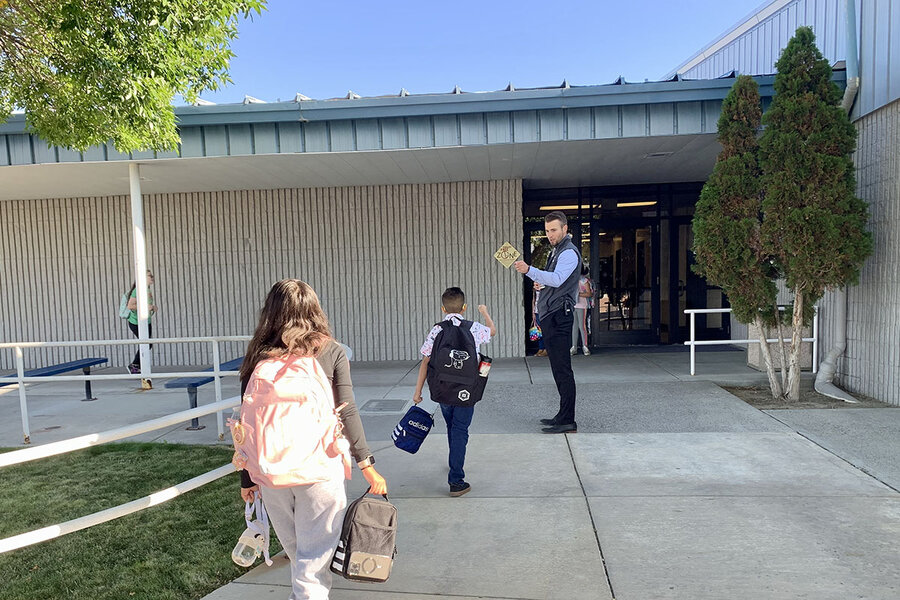Could four-day weeks lead to more progress for students?
Loading...
| ELKO, NEV.
Inside her classroom in Elko, Nevada, Sarah Blois reads her sixth grade students’ responses to a writing prompt about their weekend plans. They range from playing Fortnite to traveling for softball games.
Ms. Blois supported her district’s recent move to a four-day school week, enabling Friday to essentially become a mental health day.
Why We Wrote This
A story focused onWhat role does time play in student success? Educators are expanding and contracting school days and weeks, looking for a mix that allows instruction and young people to thrive.
“I found in my class, a lot of kids were already taking Fridays for mental health and missing instruction,” she says.
Across the United States, school districts have been grappling with a surge in chronic absenteeism, the lingering academic fallout from the pandemic, and ongoing staffing shortages. In search of a solution, education officials have been tinkering with time schedules. Some are adding hours or days, creating a longer runway for learning. Others are rearranging hours to make a four-day week possible under the belief that it will yield higher-quality learning.
The time experiments will take just that – time – before educators can definitively say whether the changes improve classroom conditions and academic outcomes.
“Part of me was like, ‘Yay, I won’t be so far behind,’” says Bryleigh Cervantes, 17, who plays three sports and would often miss Fridays while traveling for games. “And then another part of me was like, ‘Oh my gosh, I have to be at school even longer now.’”
On a Thursday morning in late August, students shuffle into Flag View Intermediate School. Parents wave goodbye, buses rumble away, and the vice principal, Jeffrey Revier, offers a greeting laced with a reminder.
“Good morning. Have a nice last day of the school week.”
His comment elicits smiles, nods, and a few startled glances. It’s the first week of the new academic year. For members of the Elko County School District, that means a major schedule change: a four-day school week.
Why We Wrote This
A story focused onWhat role does time play in student success? Educators are expanding and contracting school days and weeks, looking for a mix that allows instruction and young people to thrive.
The northeastern Nevada district, which serves 10,000 students in two time zones, slashed Fridays and lengthened the four school days after a teacher-initiated request gained community backing. It’s a gamble rooted in the theory that if students and staff have an extra day to rest, recharge, and take care of household chores, they will show up more eager to teach and learn.
Inside her English language arts classroom that morning, Sarah Blois reads her sixth grade students’ responses to a writing prompt about their weekend plans. They range from playing Fortnite and cuddling the family cat to sleeping in and traveling for softball games.
Ms. Blois supported the move to a four-day school week, enabling Friday to essentially become a mental health day.
“I found in my class, a lot of kids were already taking Fridays for mental health and missing instruction,” she says.
Across the United States, school districts big and small have been grappling with a surge in chronic absenteeism, the lingering academic fallout from the pandemic, and ongoing staffing shortages, among other challenges. With test scores showing that American students are still behind more than two years after the lockdown ended, and a mental health crisis affecting more than a third of high schoolers, the problems facing America’s education system are profound, if not existential. In search of solutions, education officials have begun rethinking the structure of the academic calendar itself. Some are adding hours or days, creating a longer runway for learning. Others are rearranging hours to make a four-day week possible under the belief that it will yield higher-quality learning.
The time experiments will take just that – time – before educators can definitively say whether the changes improve classroom conditions and academic outcomes. Even students are pondering the pros and cons.
“Part of me was like, ‘Yay, I won’t be so far behind,’” says Bryleigh Cervantes, 17, who plays three sports and would often miss Fridays while traveling for games. “And then another part of me was like, ‘Oh my gosh, I have to be at school even longer now.’”
Four-day buzz, and concerns
Gold mining powers the economy of Elko, a city of roughly 20,000 residents near the Ruby Mountains. It anchors a lonely stretch of Interstate 80, situated about three hours west of Salt Lake City and four hours east of Reno, Nevada. Many mining employees or contractors in related industries log four-day workweeks. The schools in the massive county’s more remote areas also operate on a four-day schedule. So it didn’t come as a surprise to district leaders when teachers from Elko and nearby Spring Creek started lobbying for the same schedule.
About 850 school districts nationwide operate on a four-day schedule, up 30% from 2020, according to the National Conference of State Legislatures. Most are smaller, rural districts, but in recent years, some larger districts have taken the plunge as well.
“You’re hearing more about the four-day models, not only just in education but in other professions across the country,” says Travis Monett, principal of Flag View Intermediate School.
Indeed, results from a ResumeBuilder.com survey created a buzz this summer after 20% of the 600 business leaders who responded said their company already has a four-day workweek. Furthermore, 41% indicated their companies plan to implement a shortened workweek.
But the corporate world is far removed from the classroom, where other factors weigh heavily in these decisions. For some districts, it’s about finances. A condensed school week can translate to less fuel needed for buses or lower utility bills, but cost savings generally don’t amount to more than a few percentage points of the entire budget. Other districts, Elko included, view it as an attractive recruiting tool at a time when teachers can be hard to come by, especially in rural areas.
Elko County Superintendent Clayton Anderson recommended against a districtwide four-day school week for a different reason. He worried about children with disabilities or those who rely on schools for food and support. How would one fewer day in their safe haven or a shake-up to their routine affect them?
“I was just trying to think of everybody across the board and how that might impact certain subpopulations that may not stand to benefit really much at all from this,” he says.
When Mr. Anderson moved to the Elko County School District from the Houston area in 2019, he initially served as a principal in Wells, which was already operating on the four-day model.
“I’ve got four little kiddos and I love spending time with my family, and so it’s good from that standpoint,” he says.
Last fall, the district surveyed students, parents, and staff about the proposed change. Less than a third of parents responded, but of those who did, 70% backed the four-day school week.
Sixty-seven percent of teachers and 74% of students also supported it. Some parents and community members opposed to the plan spoke at school board meetings, citing concerns such as child care.
A Valentine’s Day vote this year by the Elko County School Board sealed the deal. Five of the seven trustees cast supporting votes, approving a four-day week at every school for the 2023-24 academic year.
The change stretches the school day to seven hours and 45 minutes, keeping instructional minutes well above the state’s minimum requirement, Mr. Anderson says. Teacher and staff contracts saw an extension, too.
Additionally, the district will offer Friday meal programs and educational enrichment opportunities at select schools. And if a holiday falls on a Monday, the four-day school week will shift to Tuesday through Friday.
All the while, district officials say they will be keeping a close eye on the numbers: food need, enrichment participation, attendance, and student achievement. It’s a renewed commitment, after plans to track data in the outlying district schools that previously switched to a four-day week fell astray during the pandemic.
“Is attendance improving?” Mr. Anderson says as an example. “Because that was a big pitch from everybody. ‘Oh, we’re not going to miss as much school. We’re not going to take as many days off.’ And so is that a reality?”
More flexibility for staff
Elko High School Principal John Foss remembers a day last year when 23 of his roughly 70 staff members were absent. It kick-started a mad dash to find substitute teachers or other district employees who could cover the classes. Those situations occurred on Fridays, he says, when teachers needed to travel for their children’s sporting activities or schedule medical appointments.
The Elko County School District isn’t an anomaly. The leader of the North College Hill City School District in Ohio noticed a similar pattern last year.
Superintendent Eugene Blalock Jr. says teachers were constantly sacrificing their planning periods to serve as substitutes, and even members of the board office were jumping in to help. Now, the 1,400-student district outside Cincinnati has embarked on its own new schedule.
In North College Hill, students attend school in person Tuesday through Friday. Monday is considered a “blended learning” day, which means students work online at their own pace and teachers lesson-plan, collaborate with their teams, and do professional development.
The district’s support staff provides child care at schools on Monday for families that need the help.
Mr. Blalock says there’s not a rigid structure for online learning because they don’t want students sitting at a computer for hours. Instead, students have assignments to complete on digital reading and math programs. The district has also partnered with local companies and municipalities, he says, to provide older students with job shadowing and internship opportunities.
“Their coursework is basically completed during the four days, so anything that happens on Monday is a bonus,” he explains.
The operating theory is this: If teachers have more time to create high-quality, engaging lessons, students will excel academically as a result. And from a recruitment and retention standpoint, Mr. Blalock says he is hoping to see more teachers staying and coming to work in North College Hill, given the district’s re-imagined school week.
He acknowledges it’s an experiment, but not one he – a longtime North College Hill resident – has taken lightly. He has led the district for eight years and watched his daughters graduate from its schools. After seeing the level of burnout among his staff and its ripple effect on students, he decided it was time to innovate.
Doctors wouldn’t be asked to perform surgeries and lawyers wouldn’t be asked to argue court cases without adequate time to prepare, he says. Educators should be no different.
“I’m betting on my staff to show the professionalism that they have – and they are professionals and we need to treat them like professionals,” he says. “For so long, we haven’t treated educators” that way.
As more districts rethink schedules, Aaron Pallas, a professor of sociology and education at Teachers College, Columbia University, worries about the effects on the youngest learners, whose attention spans may not withstand longer days. On the flip side, he says the four-day model may prevent parents from pulling their children out of class for medical appointments or personal reasons, leading to fewer education disruptions.
He cautions against placing too much hope in shorter weeks until their effectiveness can be studied.
“We can speculate about these different possible outcomes,” Dr. Pallas says, “but we simply don’t have much evidence right now.”
More time, not less
Other districts are moving in the opposite direction, tacking on extra minutes or days to existing school schedules.
Richmond Public Schools in Virginia extended the academic year by 20 days at two elementary schools in a bid to reverse pandemic-related academic slides, according to the Richmond Times-Dispatch. New Mexico lawmakers, meanwhile, passed legislation increasing the number of hours required for student learning.
To meet that threshold, Santa Fe Public Schools added four school days to the year and extended the length of the day by 15 minutes. The district’s superintendent, Larry Chavez, says the magnitude of that change is apparent if measured over the long term: A kindergartner will receive an extra 2 1/2 years of learning over the course of elementary, middle, and high school.
But as far as Mr. Chavez is concerned, instruction doesn’t mean children should be anchored to their desks. Starting this year, every Santa Fe school will have four social-emotional learning days – one at the beginning of each quarter.
“It’s not always just about learning,” he says, referring to traditional academic subjects. “It’s about navigating real-world situations, building relationships, and we found that teachers and students formed a better connection through this type of day.”
When calculating the time schedule to meet the new state law, Mr. Chavez says the district preserved what it considers a crucial work window for staff – a two-hour early dismissal once a week for each grade level. It’s time that the teachers can dedicate to lesson planning or professional development.
What often gets overlooked in time debates, he says, is the instruction factor.
“If your quality of instruction within the classroom is high – it doesn’t matter if it’s fewer days and hours or more days and hours – that’s when you’ll really see the outcomes change,” he says.
“He’ll adjust”
At Northside Elementary School in Elko, the courtyard is filling up with parents and guardians at 3:45 p.m. Dismissal is 10 minutes away.
Elizabeth Gerber expects to encounter a happy but sleepy kindergartner. The nearly eight-hour days leave her daughter, who otherwise loves school, exhausted. Sean Caron’s fourth grade son, who has been diagnosed with Down syndrome, comes home wiped out, too.
“It’s tough on me. I don’t get to hardly ever see him,” says Mr. Caron, who says the schedule change came as a surprise, but he is hoping it gets easier over time. “He’ll adjust and I’ll adjust, too.”
It’s not just the students with yawns and fluttering eyelids.
Rosio Chavez, the registrar at Elko High School, starts her 10-hour workday at 6:30 a.m. She supported the new schedule, but the reality has been tougher than she imagined. Ms. Chavez says the days feel like a scramble to get everything done, especially with 100 new student enrollments and counting.
But the long workdays free up time for errands that, for Elko residents, amount to a day trip. Her plan for Fridays: “I’ll go to Salt Lake [City] and go do my grocery shopping there at Costco.”
The same principle applies for the students. School-free Fridays allow some children to help their ranching families. For others, it means missing fewer classes because of sports. Given the geographic remoteness of many Nevada towns, student-athletes face multihour car rides, often on Fridays, to compete against other districts.
And teachers say the lengthened school days provide extra time for project-based learning, in-depth discussions, and activities that previously got axed or trimmed down, such as silent reading.
“Homework shouldn’t go home because we should be able to finish it all within this class day,” says Veronica De Leon, who teaches English language arts and social studies at Flag View Intermediate School. “Then kids can go and do their sports. Kids can go home and spend time with their families.”
One week in, Bryleigh and her fellow senior classmate, Christian Felix, give an overall positive assessment. Lunch is shorter, but the days don’t feel as long as they thought they would. They’re also not bringing home tons of work.
Still, they wonder whether the four-day week will feel like a grind – as the five-day week did – come January.
“I can see it hitting hard midyear,” Bryleigh says.











